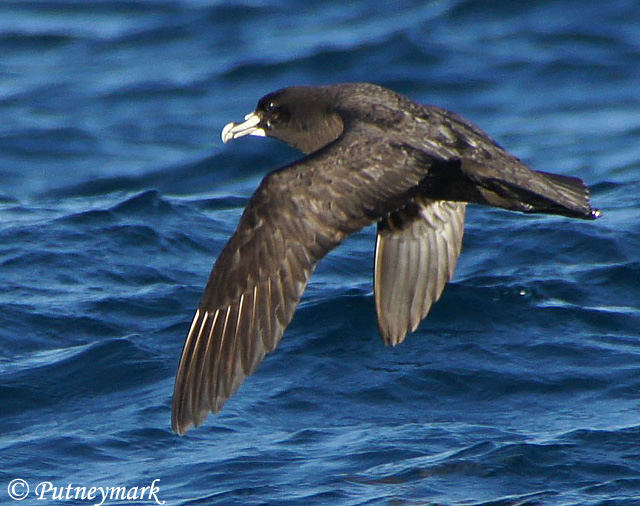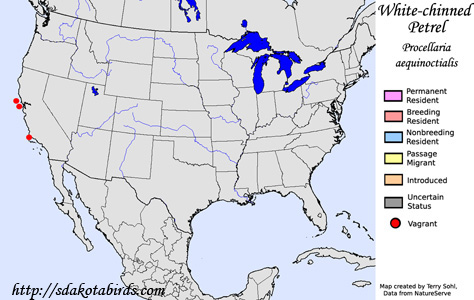| Length: 20 - 22 inches | Wingspan: 54 - 56 inches | Seasonality: Non-resident in South Dakota |
| ID Keys: Large size, dark plumage overall, pale thick bill, variable amount of white on chin and throat | ||
 The
White-chinned Petrel, also known in some locations as the "Shoemaker
Petrel", is a large petrel species of the Southern Hemisphere. They
breed on a number of subantarctic islands across the southern oceans, but
disperse more widely after the breeding season. However, non-breeding
birds typically are found well south of the equator, and they are only very
rare vagrants to the Northern Hemisphere. In North America, they are
known from a handful of sightings off the coast of California. The
White-chinned Petrel and the Spectacled Petrel were considered the same
species until 2004. They are considered one of the most vulnerable species
to mortality from longline fisheries, and populations have declined sharply
in recent decades.
The
White-chinned Petrel, also known in some locations as the "Shoemaker
Petrel", is a large petrel species of the Southern Hemisphere. They
breed on a number of subantarctic islands across the southern oceans, but
disperse more widely after the breeding season. However, non-breeding
birds typically are found well south of the equator, and they are only very
rare vagrants to the Northern Hemisphere. In North America, they are
known from a handful of sightings off the coast of California. The
White-chinned Petrel and the Spectacled Petrel were considered the same
species until 2004. They are considered one of the most vulnerable species
to mortality from longline fisheries, and populations have declined sharply
in recent decades.
Habitat: Found on subantarctic islands when breeding, using islands with soils suitable for building nesting burrows. Outside of the breeding season, found through Southern Hemisphere oceans, from subtropical waters to waters of Antarctica. Generally stays over relatively cold currents and over the continental shelf, and the highest concentrations of non-breeding birds are relatively close to breeding colonies.
Diet: Feeds mostly on fish, krill, and squid, as well as amphipods and other small marine life.
Behavior: Forages by swimming and seizing food items from near the ocean's surface. They also can dive underwater after prey. They will very actively pursue and follow fishing vessels for discarded offal, but are also susceptible to being caught on long-line fishing hooks.
Nesting: The White-chinned Petrel is the largest petrel species to nest in burrows. The female lays a single egg, and both parents help to incubate it. Upon hatching, both the male and female tend to the nestling and help feed it.
Song: Usually silent at sea, but makes a very loud and shrill chattering sound while on breeding colonies.
Migration: Widely distributed breeding colonies exists throughout the sub-Antarctic islands, with breeding colonies in the Falkland Islands, South Georgia Islands, islands south of New Zealand, and islands south of Africa. Outside of the breeding season, White-chinned Petrels range widely in the southern Hemisphere, from subtropical waters to cold waters near Antarctica. They are only rarely found north of the equator.
Interactive eBird Map: Click here to access an interactive eBird map of White-chinned Petrel sightings
Similar Species: For the rare sightings in North America, the large size, all dark plumage, and pale bill make this species unlikely to be confused with another Petrel species.
Conservation Status: Global populations have been rapidly declining. White-chinned Petrels often are caught as bycatch of long-line fisheries. In addition, breeding habitats have been negatively impacted by introduced predators. The IUCN lists the White-chinned Petrel as a "Vulnerable" species.
Further Information: 1) New Zealand Birds Online - White-chinned Petrel
2) BirdLife International - White-chinned Petrel
3) Oiseaux - White-chinned Petrel
Photo Information: Photo taken by "putneymark" - Photo licensed under Creative Commons Attribution ShareAlike 2.0 Generic License.
| Click below for a higher-resolution map |
 |
| South Dakota Status: Non-resident in South Dakota |
Additional White-chinned Petrel Photos (coming soon!!)
